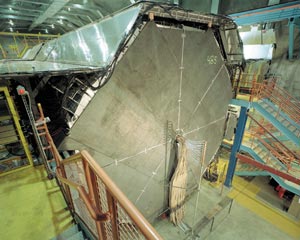
On 14 August, after four years of mining, construction and testing, the Main Injector Neutrino Oscillation Search (MINOS) collaboration announced the start-up of its 5400 tonne neutrino detector in the Soudan Underground Laboratory in Minnesota, US. The completion of the “far” detector, located 700 m underground, came nine months ahead of schedule. The installation of a smaller “near” detector at the US Fermi National Accelerator Laboratory will begin next spring and completion is expected in August 2004. Using a new muon-neutrino beamline, currently under construction at Fermilab, the MINOS experiment will measure the energy dependence of the neutrino oscillation probability and provide precision measurements of neutrino oscillation parameters.
The 30 m long MINOS far detector comprises 486 massive planes, lined up like the slices of a loaf of bread. Each plane consists of an octagonal sheet of steel about 8 m high and 2.5 cm thick, covered on one side with a layer of scintillating plastic. With a total of 28 000 m2, the far detector features the largest scintillator area of any particle physics detector in the world. A number of university and laboratory groups in the US and UK were involved in the mass production of the scintillator detector components, while the assembly of scintillator modules took place at the University of Minnesota, the California Institute of Technology and Argonne National Laboratory in the US.
Over the past three years the MINOS collaboration has conducted a series of calibration measurements with the CERN Proton Synchrotron proton beam. Led by a team from the UK, the collaboration has examined the response of a 1 x 1 x 3 m mini-version of the MINOS detectors to pions, muons and other particles with energies from 0.5 to 10 GeV. The calibration of the electronics of the near detector will take place at CERN this autumn. The first half of the MINOS far detector has been in operation since July 2002, and the MINOS collaboration was able to present its first 12 atmospheric neutrino events at a conference in April 2003.
MINOS is the first large-scale underground neutrino experiment equipped with a magnetic coil. The 1.5 T magnetic field inside the detector allows muons and antimuons to be separated, hence distinguishing between neutrino and antineutrino interactions. The results will provide a basis for the first test of CPT symmetry in neutrino processes.
Early in 2005, when the commissioning of the neutrino beamline at Fermilab is complete, the experiment will enter its next phase. Fermilab’s main injector will send 120 GeV protons onto a carbon target to create muon neutrinos with a median energy of about 3 GeV. The neutrinos will travel 735 km through the earth from Fermilab to Soudan. The near detector, located about 1 km from the carbon target, will verify the composition of the neutrino beam. The far detector will measure the deficit of muon-neutrinos caused by oscillations. More than 1000 billion (1012) neutrinos in the beam per year will pass through the far detector, and about 1500 of them will make a collision with an atomic nucleus inside the detector. Most collisions will produce a muon, but some will create an electron or a tau, indicating an incoming electron-neutrino or tau-neutrino. Although the MINOS detector is not capable of identifying individual tau events, the experiment can statistically determine the dominant oscillation mode.
The MINOS experiment should provide the best measurement of oscillation parameters associated with the “atmospheric mass-squared region”, for which the Super-Kamiokande and K2K experiments in Japan have obtained initial results. For the “solar mass-squared region”, Super-Kamiokande and KamLAND in Japan, and the Sudbury Neutrino Observatory in Canada have provided the relevant results. OPERA and ICARUS, two future neutrino experiments to take place in the Gran Sasso Underground Laboratories in Italy, are aimed at directly observing the appearance of tau-neutrinos from muon-neutrinos. These experiments will use the 730 km muon-neutrino beam of the CERN Neutrinos to Gran Sasso project, which is currently under construction and scheduled to start up in 2006.
More than 200 people from 32 institutions in Brazil, France, Greece, Russia, the UK and the US are involved in the MINOS project. Most of the funding for the experiment and the neutrino beamline at Fermilab has come from the US Department of Energy, which will have provided $171 million. The UK’s Particle Physics and Astronomy Research Council has contributed about $10 million, and about $4 million has come from the State of Minnesota, the University of Minnesota and the US National Science Foundation.







